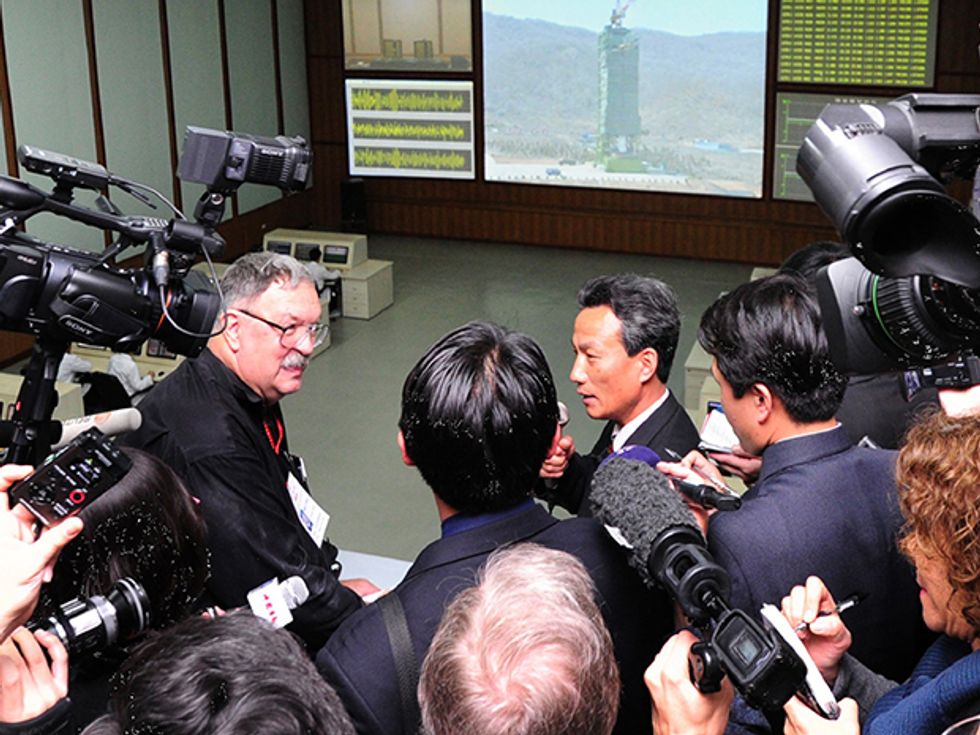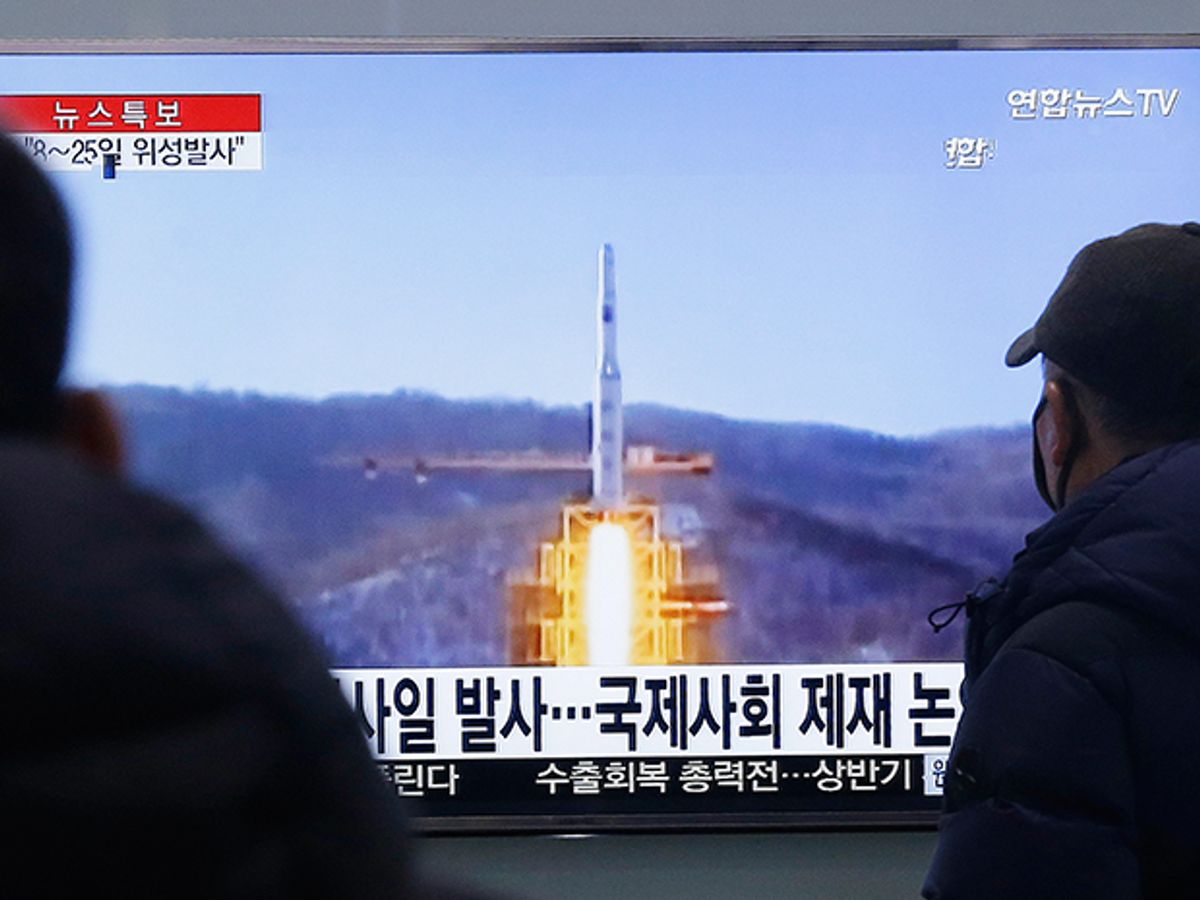Update, 7 February 2016: North Korea declares that at 9 a.m. local time it launched an “earth observation satellite” into orbit. The launch was followed by condemnation by Japan, South Korea, and the United States, who doubt the peaceful intentions of such a test. Jim Oberg’s own doubts stem from his on-the-ground observations of the North Korean space program in 2012.
North Korea has told the United Nations’ International Maritime Organization that it plans to launch a new space rocket this month, its first in more than three years. The stated aim of the launch is to deliver an Earth-observation satellite into orbit. But the plan, which comes hot on the heels of the country’s nuclear test last month, has drawn criticism and concern from a number of countries, who point out that this same technology can be used to produce a ballistic missile with a range of thousands of miles. There is very good reason to suspect that the peaceful objective is camouflage for a weapons program. To dispel any ambiguity about that point, let me offer some on-the-ground perspective.
Four years ago this April, I stood with a small group of journalists on the site of this coming launch, a rocket base called Sohae. The launch site is on a long concrete apron set amongst hills just inland from the rugged northwestern coast of the Korean peninsula. We had been invited to the site by the North Korean government to see a rocket and verify its peaceful purpose, which we were told was to launch a small observation satellite to monitor the country’s agriculture.

Everything we saw suggested just the opposite. The rocket was based on 1950s Soviet military missile designs. And the launch pad used road transport to move its rocket sections, deliver propellant, and perform other logistics. This is typical for a system that needs to be dispersed quickly to hide from enemy attacks (civilian spaceports usually use rail for transporting components and lengthy buried pipelines for fueling).
These then were features of a missile site. But I did see evidence to the contrary. Standing at one end of the apron, perhaps 50 meters from the rocket and its latticework tower, I turned and looked in the other direction. The far end of the apron was empty. But there were insets into the concrete as if for a future rail line that might lead there. And when I turned back to the rocket itself, I saw those lines lead right up to the rocket’s railway-style wheeled base. It became clear what belonged at the opposite, empty end of the apron: an unbuilt mobile service structure for assembly of even larger rockets. Such a structure—expensive to build and difficult to hide—is a feature of a space launch facility, not a military base.
We never saw the launch we’d been promised. Five days later, in total secrecy, the rocket took off and exploded. Had we been warned of the launch, we could have seen it high in the western sky from our hotel parking lot. Our hosts never told us what happened. In stunning Orwellian fashion, they seemed to forget what we’d originally been invited for, and expressed hope we’d enjoy our new activity plan: watching the unveiling of new statue of Kim Jong Il.
Once back at home, I remembered all I had seen there—especially the empty south end of the apron where the future rocket service towers were clearly intended to appear. And so you can imagine my interest when I recently saw a new set of satellite images of the launch pad. There, on the formerly empty end of the apron, was not just one tower structure, but two. And already on the pad, shrouded by weather drapes we’d also seen before, could have been a new rocket.
A rocket service tower does call to mind other civilian space efforts. Ostensibly, this new launch is a repeat of the April 2012 launch we didn’t see, and a subsequent launch in December 2012, which did succeed in putting something into orbit (North Korea’s first “something” of the sort, though it was never observed to send any radio signals).
So what is it this time? Is North Korea aiming to launch a satellite? Or will this be a test of its military missile technology?

As was the case in 2012, this new test could very well be both. It’s not clear how many stages the new rocket has, but the first and second stages of a ballistic missile launch vehicle—all that’s needed for such a launch—and a space launch vehicle are practically identical. North Korea could send up a dummy mass to test those stages. It could plan the launch so that it appears to be aiming for a north-south ‘sun synchronous’ orbit, and just drop the rocket stages along the way. The second stage nominally falls into the western Pacific near the Philippines. An additional falling object—a warhead or a mass standing in for one—would be unnoticed in the clutter. Recovery wouldn’t even be necessary. A brief burst of telemetry after a successful reentry, followed by ocean impact and sinking into very deep water, would be adequate to pull off the ruse. The masquerade could be completed by including a smaller third stage that would press on into orbit. Or, if the warhead or dummy atop the second stage is too heavy, the third stage and satellite can be entirely omitted and a “sad failure” can be announced afterwards.
Nothing we were shown in 2012 ruled out this last scenario. In fact, while we were shown a spacecraft that we were told was going to be launched, we never saw it installed atop the rocket. We saw a pointed cylindrical shroud on top of the second stage that could have held a large warhead or a third rocket stage along with a satellite or warhead; we never found out what was inside it.
I got so insistent on this issue that the exasperated control center director asked me if I wanted a chair installed on the third stage for me to ride on, to verify the presence of the satellite. I immediately accepted his offer with a grin, but offered a compromise: pictures. Then I gave him my hotel room number for delivery. He promised to send some, but they never arrived.
North Korea’s push for its own satellites is somewhat puzzling to me. As a small country, it can easily monitor its agriculture with aerial photos from aircraft. If space views are required, they can be purchased commercially from a number of companies.
But the country insists on “self reliance,” and it has pushed to create the impression among its own citizens that it already has a robust space program. The coming launch, supported by vastly upgraded launch facilities, could very well be just an insanely expensive ego-boost for the regime. That it might be camouflage for a weapons program cannot prudently be excluded. That it might be a wise investment to improve living conditions is probably the most preposterous suggestion. But the fact of the matter is that even if the goal of mission is exactly what North Korea says it is, the rocket test will still have a military benefit.
I’ll be watching with great interest—but this time, from a distance. I will never personally set foot on that launch site concrete again—of that I’m sure. In 2012, Pyongyang made two mistakes that they won’t repeat: First, they let me in; then they let me out.
James Oberg is a retired "rocket scientist" in Texas, after a 20+ year career in NASA Mission Control and subsequently an on-air space consultant for ABC News and then NBC News. The author of a dozen books and hundreds of magazine articles on the past, present, and potential future of space exploration, he has reported from space launch and operations centers across the United States and Russia and North Korea.



